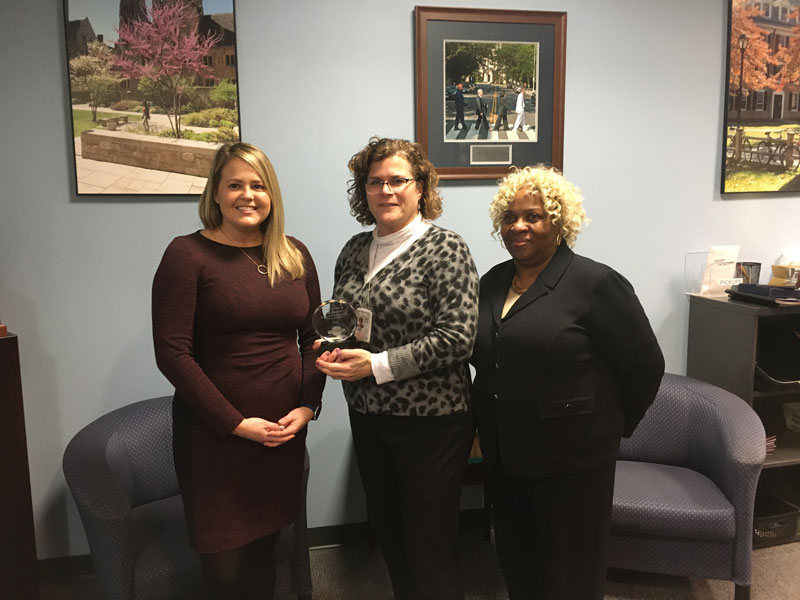

1st Place:
Yale University
Hosting Mobile Slip Simulator Training Events to Mitigate Slips, Trips and Falls
The problem:
With approximately 10,000 employees that support over 1,000 acres, 13,000 enrolled students, and 4,500 faculty, Yale University’s working conditions may present a variety of unavoidable slip hazards. This exposure is most likely to affect custodial, grounds maintenance, dining/hospitality and healthcare employees. While techniques on how to walk on a slippery surface are discussed in awareness training, hands-on training is not performed due to the complexity of the training and need to ensure the safety of the trainees. In 2018, there were 98 slip, trip and fall injuries reported within these select employee groups with a total cost of $270,000.
The solution:
Yale will coordinate 10 days of slip simulator training for approximately half of the departments’ with the greatest cost and quantity of slip, trip and fall injuries. The mobile slip simulator training event will provide hands-on experience on how to respond when walking on a slippery surface and what to do when the hazard cannot be avoided. It is designed to increase awareness and also provides kinesthetic training on how to improve stability in a controlled and safe environment. Through a memorable and engaging training experience, Yale estimates a reported reduction of slip, trip and falls of up to 70% with an anticipated cost savings of $94,000.
2nd Place:
Miami Dade County Public Schools
Establishing a Wellness Program to Combat Comorbidities
The problem:
Miami-Dade County Public Schools (M-DCPS) is the fourth-largest school district in the United States. It comprises of 392 schools, serves 345,000 students and employs more than 40,000 employees. Through regular reviews of claims data, M-DCPS identified a significant volume of claims where comorbidities were compromising the recovery of injured workers and were taking a toll on claims cost and duration. Specific to their Transportation Unit, they saw something as minor as an employee hitting a knee against a steering wheel turn into a pulmonary embolism due to obesity. In this case, what would have been a $500 claim evolved into a $500,000 claim.
The solution:
M-DCPS’s Risk Management Division developed Rebuilding Me – a loss prevention program designed to prevent injury, lower the duration of disability days related to workers’ compensation injuries, and address the comorbidities that accompany such claims by encouraging employees to engage in a healthier lifestyle. The program utilizes dedicated nurses, embedded at M-DCPS, to conduct one-on-one sessions with injured workers who were at increased risk for lost time based upon their health and wellness conditions. The Rebuilding Me team has engaged employees in fitness classes, nutritional education and ergonomic awareness activities. The program is clearly having a major impact, decreasing claims counts and costs each year. At the end of the 2018/2019 fiscal year, the overall claim count was reduced by 33% compared to the 2014/2015 fiscal year.
For photos of these activities, please visit the Instagram feed @rebuildingmemdcps. You can also view the promotional trailer by visiting: https://www.youtube.com/watch?v=LbkHwLEh1QU
3rd Place:
The SDML Workers’ Compensation Fund
Creating Grant Program to Provide Lift Equipment for Volunteer Ambulance/Fire/Rescue Services
The problem:
The SDML Workers’ Compensation Fund is a self-funded risk-sharing workers’ compensation pool for local governments in South Dakota, which includes 87 ambulance services comprised of 1,174 first responders, staff, EMTs and drivers. They also cover 227 fire and rescue departments, which include 7,151 volunteers, which are asked for lift assists in addition to the ambulance staff. Without the necessary equipment, the volunteers have incurred costly back-related injuries. For instance, one volunteer experienced 10 lifting injuries over seven years totaling $152,415 in claims. Two of those claims cost $32,000 and $38,000 respectively, and another cost $60,000.
The solution:
The SDML Workers’ Compensation Fund funds a grant program, in partnership with Stryker EMS, to members that have a volunteer ambulance and/or fire and rescue department. The purpose of the grant is to help these rural volunteer ambulance services purchase a Stryker Power-PRO™ Model 6506 ambulance cot, Stryker Stair-PRO® Model 6252 stair chair or a Stryker Power-LOAD™ Model 6390. These three products have been proven to reduce and eliminate back injuries due to lifting patients. Since being awarded a grant in 2011, the ambulance district mentioned in the claims example above has not had a single lifting injury while responding to 1,000 calls (2,000 transfers) per year. Stryker also reported a 100% reduction in back injuries in another service and a 62% decrease in the risk of developing a low back disorder when using these safety products during the loading process. This grant program has become so popular with members that the grant funds are typically exhausted by March, therefore more funds will allow them to grant up to four additional volunteer departments with lifting equipment.
